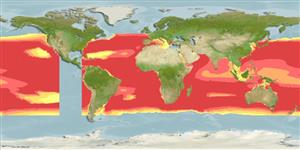Teleostei (teleosts) >
Myctophiformes (Lanternfishes) >
Myctophidae (Lanternfishes) > Myctophinae
Etymology: Diogenichthys: Taken from Diogenes, cinic philosopher who showed his comptent for the amenities of life by living in a tube, 1802 + Greek, ichthys = fish (Ref. 45335).
Environment: milieu / climate zone / depth range / distribution range
Ecology
Marine; bathypelagic; oceanodromous (Ref. 51243); depth range 0 - 1050 m (Ref. 4479). Deep-water; 50°N - 48°S, 82°W - 109°W
Atlantic Ocean: widely but unevenly distributed between 50°N and 48°S, less abundant or absent in regions of low productivity. Western Indian Ocean: between 22°S and 45°S. Pacific Ocean: widespread uneven distribution between 35°N and 25°S. South China Sea (Ref.74511).
Length at first maturity / Size / Weight / Age
Maturity: Lm ?, range 2 - ? cm
Max length : 2.9 cm SL male/unsexed; (Ref. 4479)
Oceanic, epipelagic to mesopelagic (Ref. 4066, 58302), found between 400-930 m during the day and between 18-1,050 m at night (with maximum abundance at 50-100 m and 500-700 m at night) (Ref. 4479). Larvae and juveniles non-migratory at least near the Canary Islands (Ref. 4479). Oviparous, with planktonic eggs and larvae (Ref. 31442). Minimum depth from Ref. 58018.
Hulley, P.A., 1990. Myctophidae. p. 398-467. In J.C. Quero, J.C. Hureau, C. Karrer, A. Post and L. Saldanha (eds.) Check-list of the fishes of the eastern tropical Atlantic (CLOFETA). JNICT, Lisbon; SEI; Paris; and UNESCO, Paris. Vol. 1. (Ref. 4479)
IUCN Red List Status (Ref. 130435)
Threat to humans
Harmless
Human uses
More information
ReferencesAquacultureAquaculture profileStrainsGeneticsElectrophoresesHeritabilityDiseasesProcessingNutrientsMass conversion
Tools
Special reports
Download XML
Internet sources
Estimates based on models
Preferred temperature (Ref.
123201): 8 - 20.6, mean 13.4 °C (based on 1072 cells).
Phylogenetic diversity index (Ref.
82804): PD
50 = 0.6250 [Uniqueness, from 0.5 = low to 2.0 = high].
Bayesian length-weight: a=0.00692 (0.00297 - 0.01609), b=3.13 (2.93 - 3.33), in cm total length, based on LWR estimates for this (Sub)family-body shape (Ref.
93245).
Trophic level (Ref.
69278): 3.1 ±0.25 se; based on food items.
Resilience (Ref.
120179): High, minimum population doubling time less than 15 months (Preliminary K or Fecundity.).
Fishing Vulnerability (Ref.
59153): Low vulnerability (10 of 100).
Nutrients (Ref.
124155): Calcium = 231 [62, 717] mg/100g; Iron = 0.79 [0.28, 2.64] mg/100g; Protein = 16.2 [14.3, 18.0] %; Omega3 = 0.377 [0.126, 1.088] g/100g; Selenium = 11.7 [3.2, 37.1] μg/100g; VitaminA = 132 [15, 1,108] μg/100g; Zinc = 1.34 [0.64, 3.01] mg/100g (wet weight);
